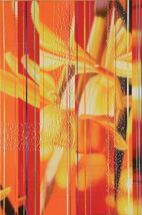






|
|

Dany Vescovi è nato a Milano nel 1969, dove vive e lavora.
Hanno detto di lui
“Vescovi (paradossalmente, dato che per costruire i suoi pezzi muove da una figura tratta dalla realtà) presenta maggiori affinità con la grande stagione astratto-geometrica americana, con Neo-Geo, tanto per fare un esempio, piuttosto che con le composizioni di figure e sfondi, di primi piani e interni, che contraddistinguono l’italian-style odierno.
Al centro della sua ricerca, infatti, ci sono la luce, il colore, le linee, le velature, ma non sono utilizzate per edificare una riproduzione della realtà, per dare vita a un mondo comunque simile all’originale. Sono trattate riflessivamente, in studi che si succedono uno all’altro come esperimenti, che hanno certamente una scusa e un pretesto di fondo (per Vescovi, le forme dei fiori e quelle più elementari della vita animale, per Halley la schematizzazione dello sky-line e dei contatti d’una metropoli) ma che presentano come focus l’analisi delle variazioni della materia. Non importa se si tratti di gigli o di anemoni, come non interessa, nei pezzi di Halley, che quadrati e tratti siano i palazzi di New York e i suoi condotti sotterranei: ciò che conta è come, col muoversi delle forme, con l’incontrarsi delle superfici, cambino la trasparenza e gli spessori, il segno della definizione e la tonalità del fondo. Membro a tutti gli effetti della nuova figurazione, Vescovi si accompagna idealmente a Taaffe, a Dona, a Marcaccio, ai maestri dell’immaginazione astratta. Coi quali divide anche la passione per la terza dimensione, per la sperimentazione dei materiali con cui dipingere, per un disegno dalla pelle rugosa e palpabile, per uno spessore fisico (e non solo ideale) dell’olio e dell’immagine”. (Maurizio Sciaccaluga).
Mostre personali/One man shows
2005 “De modo amalgamandi”. Pfortnerhaus, Feldkirch, Austria (con Paul Renner).
2004 “Hybris”. Bonelli, Arte Contemporanea, Mantova.
2003 “Flower power”. Guidi & Schoen Arte Contemporanea, Genova.
“Immagini da immaginare”. Palazzo Frisacco, Tolmezzo (UD).
“Textures”. Palazzo del Broletto, Como (con D.Nido).
“Dissezioni”. Dellapina Arte Contemporanea, Pietrasanta (MS).
2002 “Natura Naturans”. Galleria Paolo Majorana, Brescia.
“Dany Vescovi”. Betta Frigeri Arte Contemporanea,
Sala Barbolini, Sassuolo (MO). “Incontri ravvicinati”.
Dellapina Arte Contemporanea, Massa.
2001 “Scansioni”. Nuova Artesegno, Udine.
“O3“. Kunstflur Spandau, Berlino, Germania.
2000 “Dany Vescovi”. Nuova Artesegno, Udine.
1999 “Microcosmos 2”. Nuova Artesegno, Udine.
“Microcosmos 1”. Ciani Arte Contemporanea, Genova.
1998 “Dany Vescovi”. Betta Frigeri Arte Contemporanea,
Sassuolo (MO).
1997 “Naturalmente … affini”. Studio Cannaviello, Milano.
“Dany Vescovi”. Marella Arte Contemporanea, Sarnico (BG)
1996 “L’immagine della pittura”. Monopoli Arte
Contemporanea, Pavia.
“Dany Vescovi”. Galleria Flaminio, Rimini.
“Dipinti 1994-1996”. Galleria Medusa, Cesena (FC).
1995 “Flowers”. Marella Arte Contemporanea, Sarnico (BG).
1993 “Tricicli“. Eos Arte Contemporanea, Milano (con F.Guida e D.Nido).
Dany Vescovi is born in 1969 in Milano, where he lives and works.
A word from the critics
«Vescovi (paradoxically, given that in constructing his works he starts from a figure drawn from reality) shows greater affinities with the great American abstract-geometric movement Neo-Geo, just to give an example, rather than with the compositions of figures and backgrounds, close-ups and interiors, that feature in the latter-day Italian style.
His work in fact centres on light, color, lines, hues, but they are not used to build a reproduction of reality, but to give life to a world that is all the same similar to the original. They are dealt with reflectively, in studies that follow on from each other like experiments, they certainly have a basic justification and pretext (for Vescovi the shapes of flowers and the most elementary ones of animal life, for Halley the schematisation of the skyline and the contacts of a metropolis) but that focus on the analysis of the variations of the matter.
It is no matter whether they are lilies or anemones, in the same way as in Halley’s works it is of no interest whether the squares are the building of New York or underground pipelines: what counts is how, with the moving of shapes, with the encountering of surfaces, transparencies and the thicknesses, the defining marks and the background tones change. To all intents and purposes a member of the new figurative movement, Vescovi ideally goes with Taaffe, Dona and Marcaccio, to the masters of abstract imagination. With whom he also shares the passion for the third dimension, in experimenting with the materials he uses for painting, offering a wrinkly, palpable drawing of the skin, for a physical (and not only ideal) depth of oils and the image».
(Maurizio Sciaccaluga)
|
|

Q x cat 024
2005, olio su lino, 60x40
|